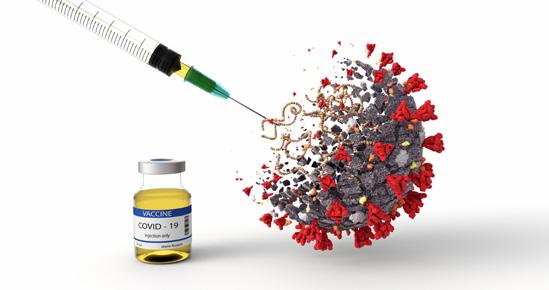
16 minute read
EVENT RECAP
Research and Practice in OPERATIONS MANAGEMENT
We are living in unprecedented times and such times call for pathbreaking innovations and their implementation at rocket speed. Gone are the days when it used to take years in defining the need for change and then working on it. The last year, thanks to Covid19, taught us to be on our toes in bringing about change at the fastest pace ever to sustain and survive in the globally turbulent and dynamic marketplace. This was a strong message from the recently held e-Conference hosted by Symbiosis Institute of Operations Management Nashik with the theme, “Research and Practice in Operations Management: Lessons from COVID-19”. The International Conference on Operations and Supply Chain Management (ICOSCM 2021) provided insights on challenges and shortcomings that Covid-19 has exposed in supply chains. This report provides you a quick takeaway of the thoughts of the keynote speakers as well as the winners of the Best Research Papers Award, held during the day-long summit. We were especially thrilled to listen to the keynote speakers’ views on how operations management would shape up in the future and how can companies prepare themselves for the change.
Advertisement
In the words of Dr. Vandana Sonwaney, Director, SIOM, “The domain of Operations Management has always been a challenging endeavor owing to its turbulent and uncertain nature. But what it has been witnessing during the times of the COVID-19 pandemic is so unprecedented and drastic that it signals a distress call for immediate intervention by strategic revamping through well thought-out and prudent restructuring of supply chains to alleviate the challenges for businesses across the globe. This demands an extensive and exhaustive display of scholarly work from the greatest and accomplished minds under the gamut of Operations Management.”
Keeping these thought-provoking insights in mind, the main objective of SIOM’s International Conference on Operations and Supply Chain Management (ICOSCM 2021) was to aim for greater insights on the challenges and shortcomings that an unprecedented pandemic like COVID-19 has exposed in the world of operations, from the experts as well as the researchers. Let us hear it from the winners on their ideas and how they are going to transform the operations management domain…

What is the inspiration behind this winning paper? How did this idea strike you?
Rofin T M, Assistant Professor, School of Management, National Institute of Technology, Surathkal:
In the COVID-19 era, all of us are hesitant to visit retail shops especially when they are crowded. This fear was intense during the country-wide lockdown period. Numerous customers switched their purchases into online channels even for essential items such as groceries and vegetables. It can be said that COVID-19 fostered the online buying behavior of customers, which was already established owing to the skyrocketing smartphone sales. This scenario inspired me to think of a supply chain configuration comprising only of online sales channels and that is the basis of my paper, “Optimal dual-online
channel supply chain configuration
of a manufacturer”.
I am working in the logistics industry from last 5 years and actively working with stakeholders of supply chain. Covid-19 came up with lots of challenges and opportunities where we can work together. Post Covid-19, it was the time of reality check to understand as to why this industry got stuck for 2-3 months, what were the causes and what could be the strategies, which may be helpful for these types of situations going forward to tackle these firefighting situations. This is what inspired me to work on my paper, “Third-Party Logistics Supply
Chain in Covid-19: Challenges and
Strategies”.
Pushkar Chaturvedi, Senior Account Executive, FedEx Express TSCS Pvt. Ltd.: According to you, what are the tangible gains companies can achieve with your proposed research? Rofin T M: Online sales channels have created a level playing field enabling small players to compete with big established firms having deep pockets. Online channels also helped small manufacturers and sellers to avoid middlemen making the products available at a lower price for the customers. Most importantly, small manufacturers and sellers can enter the market without huge capital investment if they resort to the supply chain configuration proposed in the research.
Pushkar Chaturvedi: Endeavour of this research is to build an impactful plan for contingency situation. We are trying to build strategies, which will help this industry to build a strong action plan for challenging situations like Covid-19. This research will provide guidance to 3PL organizations to train employees for emergency situations.
What are the immediate challenges that companies are facing in managing their supply chains and how does your research address the very challenge? Rofin T M: The current challenge that supply chains are facing is the resiliency. COVID-19 was an acid test for the supply chain resilience. Sudden demand disruptions and supply disruptions tested how quickly the supply chains can adapt to the changes in market conditions. Online distribution channels were highly effective during the pandemic owing to the flexibility in operations. In that sense, the proposed supply chain configuration can be said to have a better resilience.
Pushkar Chaturvedi: As per my research, the immediate challenge in managing supply chain is demand forecasting due to lack of information flow between the supply chain stakeholders. My research findings indicated that 3PLs are facing challenges in managing capabilities due to lack of information about upcoming demand from customers. With the help of impacts information system, we can bridge this gap between customers and 3PL organizations. How should organizations work towards steering their supply chain in the right direction in the Next Normal? Rofin T M: The organizations should identify the supply chain vulnerabilities as a first step to increase the supply chain resilience. Because of the increased frequency of supply chain disruptions, it is imperative for the organizations to diversify their supply base geographically i.e., adding more sources in locations not vulnerable to the same risks. Further, decisions on safety stock and positioning of safety stock in the value chain are also critical decisions to be made by supply chains in the next normal. It is also important for supply chains to take advantage of the new process technologies such as additive manufacturing and continuous flow manufacturing for improving the supply chain flexibility.
Pushkar Chaturvedi: Now organizations need to understand the importance of contingency plan. They should focus on building a robust flow of information among the supply chain stakeholders like suppliers, manufacturers, marketplaces, 3PL services & regulatory agencies to create a win-win situation for everyone. They should work upon demand forecasting and planning of capabilities management based on information from other stakeholders. Organizations should now focus on technology development to work in emergency. They should also provide training to their employees to react promptly to these firefighting situations. Organizations should also focus on building infrastructure to cater to the booming demand, specially from e-commerce growth in India.
KEYNOTE 1 THE DIGITAL CONNECT

A crystal gaze from Subodha Kumar, Anderson Distinguished Chair Professor of Supply Chain, Marketing, Information Systems, Statistics, Fox School of Business, Temple University…
Whenever you run with low inventory, lot of inefficiencies get exposed in the supply chain and the same challenge was evident during the COVID-19 period with the lockdown being imposed by countries. It’s a Wake Up call for all of us that we need to do a much better job in our operations and supply chain systems. With COVID-19, we are going to see a fundamental shift in the way supply chains have been functioning over the years.
I would like to bring to you a classic example of 3M as to how it took the situation in its control and quickly adapted to the New Normal. At the start of the pandemic in the early January 2020, demand for N95 masks and healthcare equipment was on the rise, while other items were seeing a demand slump. 3M responded to this with an operational pivot: significantly ramping up production in some areas but cutting inventory elsewhere.
The manufacturer developed surge capacity during the SARS outbreak in the early 2000s — and two decades later, that experience enabled it to quickly accelerate production of high-priority SKUs during the COVID-19 pandemic. The manufacturer began ramping up production of N95 respirators in January, from 22 million per month prepandemic to 26 million. By June 2020, 3M was making 50 million respirators per month. It added two new respirator lines at a Wisconsin plant in Q3. It dropped non-critical SKUs and refitted production lines for critical supplies.
All this was possible because of an enhanced technology system that the company invested in. 3M put its critical shipments on a renowned technology platform it has invested in to get realtime data in one place, which allows 3M to keep less buffer stock on hand. Getting parcel tracking live took less than one week. 3M's response does prove the value of real-time data and agility. Forecasting based on historical models was rendered ineffective during the pandemic, with real-time data proving more valuable. And demand shifted quickly at the consumer level, amplified the supply chain via the bullwhip effect and requiring suppliers to adjust on the fly.
With this example, I would like to reiterate the fact that your uncertainty is much less because you exactly know where the item is. That data translates into aligning inventory orders closely with demand, allowing the lean operations and balance sheets many supply chains strive to achieve.
VACCINE DISTRIBUTION
Now as we are into the pandemic situation for almost a year and the vaccine is already out, the next issue in front of us is vaccine distribution. Last mile distribution and storage are going to be bigger challenges in managing the supply chain. We have to look at all these issues from the new lens. Technological interventions are going to be the catalysts in the way we manage supply chain globally. Talking about digital transformation, we have AI, machine learning, business analytics, etc. As far as business analytics is concerned, two things are emerging right now – we are witnessing a stream of data analytics, predictive model, etc. Another angle is from supply chain optimization perspective. Both have to work together to arrive at a holistic solution we need currently. It will lead to lot of interesting research and the academia will need to play an enabling role to solve such critical problems.
EMERGING TECHNOLOGIES
If you think of digital innovations in healthcare, blockchain was clearly emerging as the next technology to bank on even before the pandemic. Blockchain in pharmacy is going to catch up faster than we could even imagine. Early

movers will have the advantage in pulling this off. We shouldn’t be delusional that the life will be back to normal once the vaccination starts. We have to be ready for many such disruptions coming our way in the future as well. Blockchain technology could certainly provide an answer to these eventualities. Cold chain monitoring is a big deal and if blockchain can offer an end-to-end visibility into the system, then it will be a real gamechanger.
AI IN HEALTHCARE
Virtual reality was another area that was already taking shape, but now owing to the lockdowns, this became the ultimate need of the hour. Chatbots also came as great alternative for solving customers’ immediate redressal. Now, with the COVID-19 pandemic and social distancing, telehealth is more useful than ever. Online question and answer (Q&A) forums where patients can directly raise their questions or concerns to their doctors are one of the most efficient methods of telehealth. These forums are beneficial for many common medical issues that can be solved simply from a doctor’s response, rather than an in-person visit.
In countries like China and India, there is a huge gap between healthcare in rural and urban settings. The big cause for the emergence of these (telehealth) platforms was to solve inefficiency in the system. What we are seeing longterm is that hesitancy is gone. People have done it and they are comfortable with it now. It’s more convenient. These platforms also give patients the chance to provide feedback back to the doctors, a chance they would not typically have in the traditional healthcare system. They are now able to provide their anonymous views and opinions, which can help improve the healthcare system in general.
If we look at the big picture, systems like eBay are simply connecting the buyers and sellers. It is the same for these online healthcare platforms. They are connecting people. The online connection between patients and doctors is proving to be more efficient and costeffective long-term, as well as beneficial for both the doctor and patient. As people are encouraged to reduce social interaction, this form of telehealth has a promising future to play a much bigger role in healthcare.
Going ahead, we will see a lot of convergence between traditional supply chains as well as emerging ways of managing supply chains to strike a perfect equilibrium and develop a futureready and efficient supply chain.
KEYNOTE 2 EMBRACING DIGITAL CHANGE
The first-hand account of Dr Samir Yerpude, Deputy General Manager, Tata Motors, where he talks about the muchneeded thrust on technology adoption in the operations management…
To start with, let me ask you a simple question… What was the biggest learning or the outcome of the Covid19 pandemic on organizations? It is significantly this… We have developed resilience against unforeseen situations. Companies came up with the innovative ways to connect with the customers. Sectors such as e-commerce, healthcare, pharma, and education sector were the major traction points towards resurgence. We also saw agility in the adoption of digital technology. To bring to your notice, what was our 5-year agenda towards digital adoption, we could achieve that in just about one year, all thanks to the pandemic. We had to ensure business continuity even during pandemic to survive and sustain our market share. This is where the thought leadership comes into picture. We have achieved a more collaborated and digital supply chain management where digital has touched every aspect of business.
TECHNOLOGY RENAISSANCE
We are witnessing a great disruption happening in the operations management with lean manufacturing and IoT shaping up the pace of operations. All of these is leading to a better customer experience. Digital transformation encompassing big data analytics and machine learning are redefining the way operations and supply chains have been functioning over the years.
Cyber-physical systems dictate the current Industrial revolution 4.0 while firms are embarking the Industry 5.0 journey. With the experts nowa-days talking about Industry 5.0, we are essentially speaking about personalization for the customer in every segment and that calls for a connected ecosystem with the highest collaboration.

Characteristics such as small batches yet upholding the economies of scale is the Present. Innovations such as Internet of Things (IoT) help collaborate between the physical and virtual environments which assist the collaboration. Isolation between the systems is avoided and comprehensive view gets generated with the real time data emerging from the IoT landscape.
DELIVERING THE CUSTOMER EXPERIENCE
Customer experience is the new brand image, and the longevity of organizations is dependent on the same. The great marketing guru, Phillip Kotler had once mentioned that key to customer retention is customer satisfaction. Statistics reveal that existing customer base supports 60% of the future business, therefore customer retention becomes vital for an organization. Best prices, agility and connectedness are some of the fundamental expectations from today's customer. Organization leaders will have to align the strategies and view it in the light of the New Normal to retrieve business and gain back their positions which is a huge potential still to be tapped with emphasis on Make in India. In my experience, customer experience is going to drive businesses going forward. To accomplish this, the highest level of process efficiency is obligatory, and this is where operations management is expected to deliver.
CLOSING THOUGHT
The proliferation of new business models will take place across most of the sectors in India. Business processes will undergo a significant change post the pandemic unleashing large number of opportunities. The New Normal can be visualized with all sectors having a strong Digital footprint. Businesses which were never visualized to be on the e-commerce platforms will mark their presence and flourish on Internet. A paradigm shift is waiting for all of us in the nearest future while the world will unlock in phases. Businesses globally are currently under tremendous pressure and awaiting the lockdowns to be lifted. Supply chains are stressed with the equilibrium between demand and supply skewed. Anxiety and panic buying have resulted in a bullwhip effect in most of the categories, which will take a while to stabilize. Under such circumstances, Digital will play a vital role.
Businesses embracing Digital will have a much higher probability of survival. The longevity of organizations not having Digital channels will be jeopardized. Real time customer data collated with the help of Internet of Things will enable businesses execute AI algorithms to predict the future. As organizations will change, consumers also must undergo a change. Organizations will look forward to innovating and co-create opportunities for consumers keeping in mind the personalization factor. In short, it is quite an exciting journey ahead for the bullish and grueling times for the bearish.
The supply chain:
The new protagonist and the stress test
SINCE the 2008 financial meltdown, regulated financial institutions globally have been forced to stress test their balance sheets to assure preparedness for an economic shock. Governments would not have it any other way. Similarly, a series of large-scale cyber-attacks in the past 10 years has forced technology companies to institute penetration tests to scrutinize their cyber-security mechanisms. Boards of directors will not have it any other way.
In a post-COVID-19 world, supply chain stress tests will become a new norm. The distributed global business model, optimized for minimum cost, is finished. Tomorrow’s model demands new priorities in optimization.
The supply chain has become a main protagonist everywhere, it has moved from playing a “behind the scenes” organizational role to being a prime driver of the company business.
In the past, volume stability enabled the supply chain to deliver with a high level of service while lowering costs at the accepted quality. However, supply chains and manufacturing plants allow minimal flexibility in terms of volume – as the struggle to fulfill ventilator demand has exposed.
As volumes become more variable, supply chains must become more adaptive, especially if, as forecasts suggest, large suppliers and logistics operators in the supply chain industry must prepare for major catastrophic events such as weather events (fires, flood, tsunami), lethal pandemic outbreaks, strikes, social unrest and associated disruptions.
To manoeuvre choppy waters, navigators need visibility. In certain industries, such as microprocessor development or consumer technologies, advanced electronics manufacturers have already produced comprehensive dashboards that lay out the full status of production and shipment, down to the last detail. The dashboards refresh every 20 minutes to provide a real-time overview of the entire supply chain.
Such technology will inevitably emerge as the norm. Consider the pharmaceutical industry, for example, where there is currently no single database, either centralized or distributed, from which to map the critical components for drug manufacturing. For suppliers, and ultimately, end-users, the visibility on sourcing is critical and must be upgraded. Source: IMD






